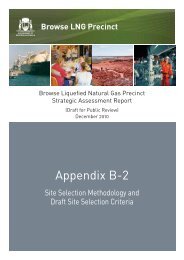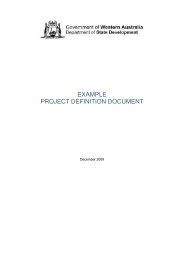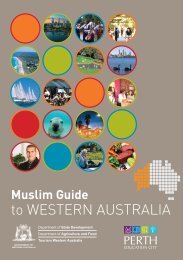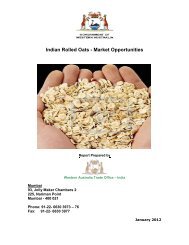Browse LNG Precinct - Public Information Booklet - Department of ...
Browse LNG Precinct - Public Information Booklet - Department of ...
Browse LNG Precinct - Public Information Booklet - Department of ...
You also want an ePaper? Increase the reach of your titles
YUMPU automatically turns print PDFs into web optimized ePapers that Google loves.
<strong>Public</strong> <strong>Information</strong> <strong>Booklet</strong><br />
Activity Description<br />
Fuel and chemical<br />
storage<br />
During construction a fuel and chemical storage area will be<br />
required. Where practicable these facilities will be retained<br />
for operations.<br />
Water supply During construction a water supply will be required both for<br />
potable and construction water. Depending on the quality<br />
required there are several sources <strong>of</strong> potential water supply,<br />
in order <strong>of</strong> preference, including surface aquifers, the<br />
confined Wallal aquifer and desalination <strong>of</strong> ocean water if<br />
these are not viable. Where practicable these facilities will<br />
also be used for operations.<br />
Waste water treatment A waste water treatment plant and associated outfalls will<br />
need to be developed for both the <strong>LNG</strong> facilities within the<br />
<strong>LNG</strong> <strong>Precinct</strong> and the operations and construction camp.<br />
Question ñ How many storage tanks will be built and how tall will they be?<br />
It is expected for the recinct that there will be up to that there will be up to 8-12 <strong>LNG</strong><br />
Tanks and up to eight condensate tanks. This is for the maximum development in the<br />
<strong>Precinct</strong> <strong>of</strong> up to 50 million tonnes per annum.<br />
For the foundation proponentís initial development (three trains) there will be two to three<br />
<strong>LNG</strong> tanks and two condensate tanks.<br />
The height <strong>of</strong> <strong>LNG</strong> Tanks will be about 35-45 metres (115 to 150 feet).<br />
Heritage Protection<br />
Question - What are the clauses in legislation that give protection to heritage sites?<br />
Aboriginal heritage sites are protected under various parts <strong>of</strong> the Aboriginal Heritage Act<br />
1972 (WA) and the Commonwealth Aboriginal and Torres Strait Islander Heritage<br />
Protection Act 1984. If sites are national heritage listed or nominated to be listed, they<br />
can also be protected under the Commonwealth Environment Protection and Biodiversity<br />
Conservation Act 1999.<br />
In relation to plants and animals that are important to Traditional Owners, the KLC are<br />
undertaking what is called an ethnobiology survey. This will record information about the<br />
importance <strong>of</strong> plants and animals in and around James Price Point from Traditional<br />
Ownersí perspective rather than from a western scientific perspective. In addition, there<br />
will be an opportunity to record plants and animals <strong>of</strong> importance during heritage surveys<br />
undertaken for the <strong>Precinct</strong>. Once the ethnobiology and heritage surveys have been<br />
completed we can look at including the management measures identified in<br />
environmental and cultural heritage management plans as included in the Heads <strong>of</strong><br />
Agreement.<br />
5279225 79









